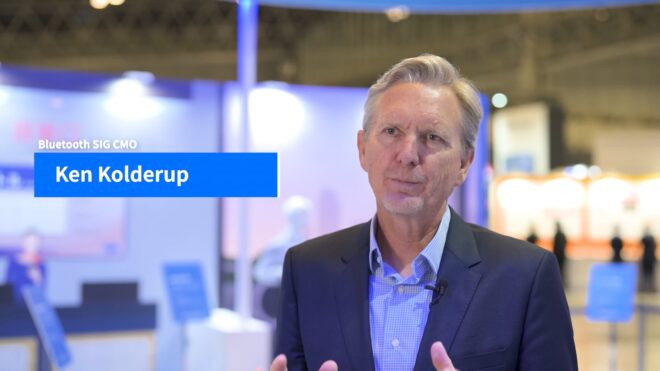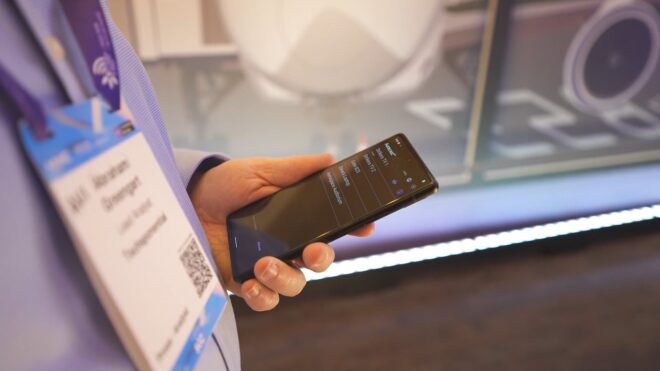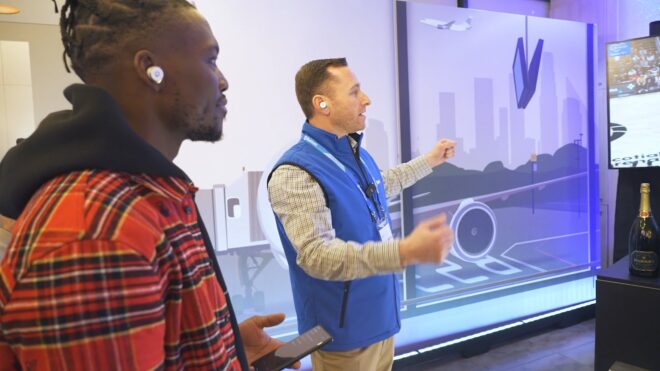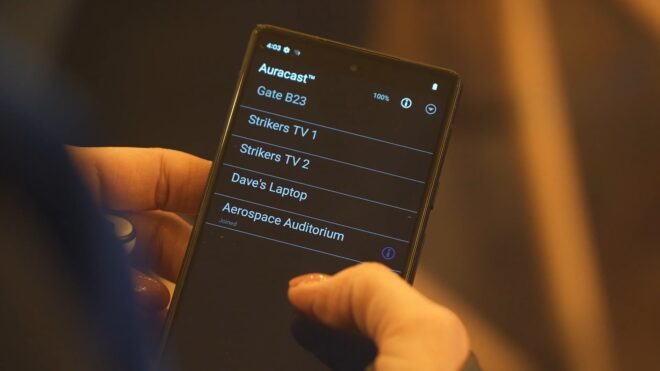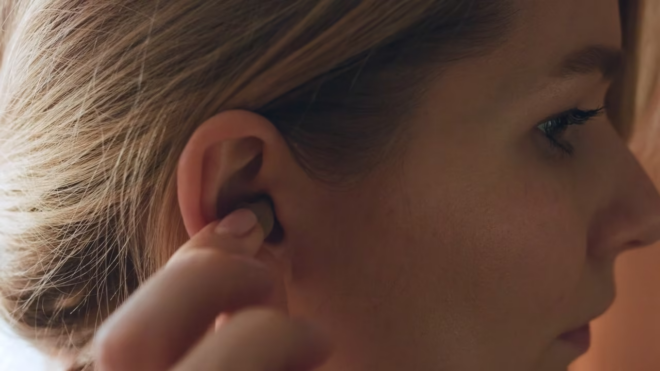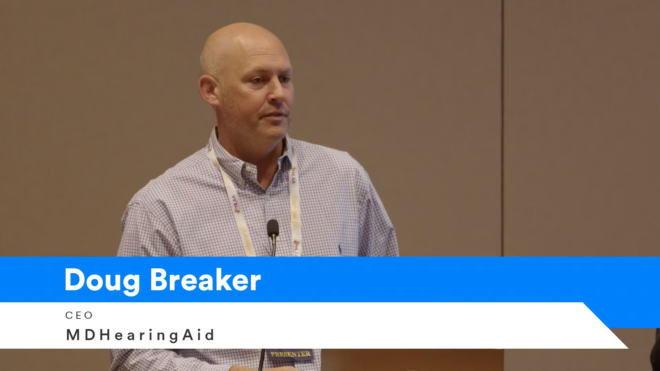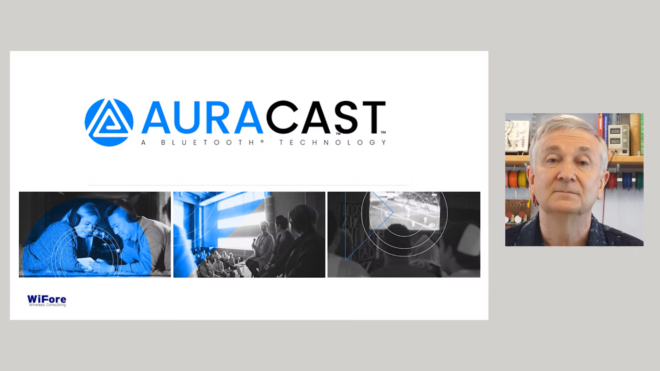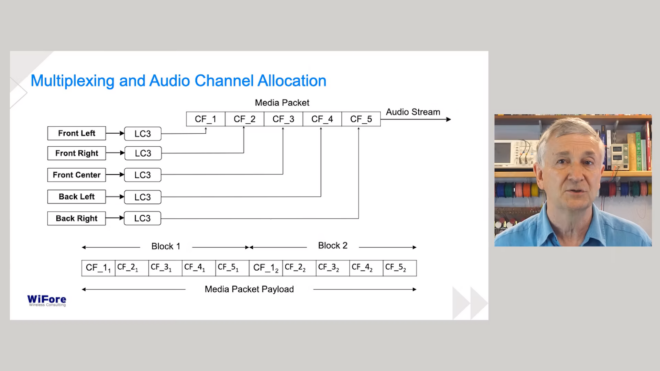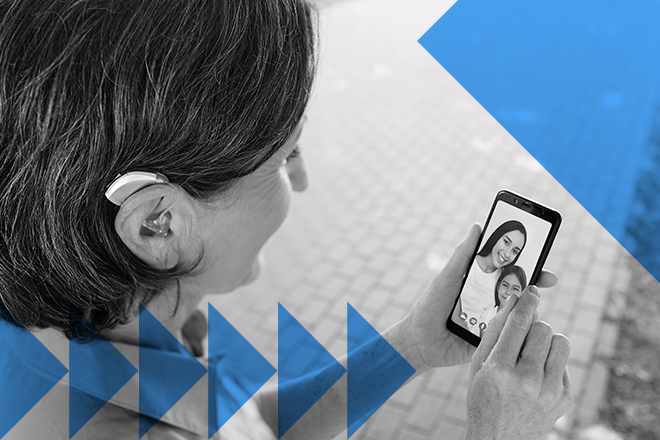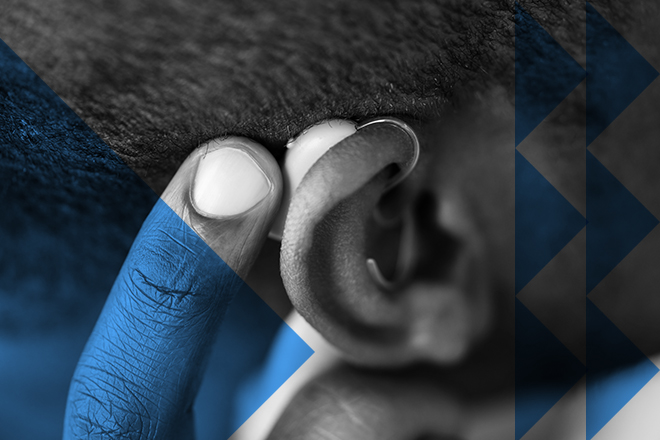Download the presentation deck View the webinar Q&As
Bluetooth® technology has introduced Auracast™ broadcast audio, a new capability that enables an audio transmitter to broadcast to an unlimited number of nearby audio receivers. Auracast™ broadcast audio promises to deliver life-changing audio experiences, enhancing the way people engage with others and the world around them.
What do audio developers and public locations need to know about Auracast™ broadcast audio, what impact will this innovation have on the wireless audio market, and how can public locations enhance their visitor experience with Auracast™ broadcast audio?
In this webinar, Chuck Sabin, Senior Director of Market Development at the Bluetooth SIG will:
- Discuss the three primary use cases Auracast™ broadcast audio will enable and the benefits it will bring to locations deploying the new capability and the people who visit those locations
- Outline what audio developers need to know in order to integrate Auracast™ broadcast audio into their wireless audio devices and systems
- Introduce resources and recommendations for public locations deploying Auracast™ broadcast audio, along with opportunities to brand your location
- Explain how Auracast™ broadcast audio can become the next generation of assistive listening systems, helping drive broader adoption of hearing assistance at public locations
- Present new forecasts for Auracast™ device shipments as well as analyst predictions for the number of deployments, the types of locations that will adopt early, and the use cases they will implement
- Offer realistic timelines for the adoption of Auracast™ broadcast audio
- Review additional features and benefits of Bluetooth® LE Audio
Don’t miss this discussion about a powerful capability that introduces new opportunities for wireless audio developers to enable imaginative audio experiences and allows public locations to enhance their visitor satisfaction while increasing audio accessibility for all.
Webinar Questions and Answers
Is there an estimated year on when the majority transition between Classic and LE Audio would occur?
Please refer to the most recent Market Research Note on LE Audio and Auracast™ broadcast audio forecast and deployment estimates.
Will cell phones operate as an Auracast™ Transmitter?
Yes. Cell phones can qualify using the Source role from the Public Broadcast Profile (PBP) to enable Auracast™ broadcast audio transmissions from the smartphone. Primarily this will be used in the personal sharing use case mentioned in the presentation.
In case of a private audio broadcast, is there any authentication feature to only allow access to authorized listeners?
The specification does allow for an encrypted broadcast code for private listening.
What types of devices will send out Auracast™ broadcast audio into a room? Dedicated transmitters or built into other devices like WiFi access points?
For public spaces, it will be a central broadcast transmitter. This can take on many forms. It can be a dedicated Auracast™ transmitter, or it can be integrated into other devices, such as a WiFi AP. Auracast™ broadcast audio can even be directly integrated into an audio source like a microphone for live audio events and tour systems. This is up to the innovation of the device and system manufacturers.
Does the LC3 codec change the sound quality?
The LC3 codec has a variety of compression settings. What is required and optional for LC3 is defined in the LC3 specification. Please remember, for Auracast™ broadcast audio, there are specific requirements defined in the Public Broadcast Profile (PBP).
Does Auracast™ broadcast audio work with current Bluetooth hardware, or do all devices, both receivers and transmitters, have to be replaced?
The new specifications allow for upgradability of existing products in the field. Whether field upgrades occur will depend on the underlying Bluetooth® capabilities already in a device and the supplier’s product strategy. We do expect some product types will be upgradeable but do not have visibility into specific product strategies.
Can you say anything about latencies from an Auracast™ broadcast audio host to sink devices? I.e., how usable will Auracast™ broadcast audio for live talks, etc.?
This will vary by manufacturer. Many are targeting less than 20ms latency.
Do you see a possibility to create public alerts (in broadcast) that act as push notifications for smart devices like a smartphone? (e.g., to alert flight delay or other specific information)
These are all good use cases for Auracast™ broadcast audio. The example of a flight delay does not need to originate from the smart device. This can originate from an Auracast™ broadcast public address (PA) for the specific gate, as an example.
We want Auracast™ broadcast audio to be universal. How can we make sure that no manufacturer will make proprietary variant of Auracast™ broadcast audio?
Auracast™ broadcast audio, by definition and requirements, is universal. A proprietary variant will not carry the Auracast™ name or trademarks. We are working closely with the ecosystem – including Pro AV, hearing aid, consumer source devices (e.g., phone, tablet, PC, and TV), consumer hearing devices, and audio infrastructure suppliers – to ensure wide adoption and deployment of Auracast™ broadcast audio.
How many channels can be used for Auracast™ broadcast audio? This question could be related to the number of audio channels available in the same area?
Theoretically, the number is unlimited. However, this may be limited by the resource availability of the hardware. Please consult the individual manufacturer.
Is there a place/city/country where the Auracast™ broadcast audio has been tested with cochlear Implants?
Not that we are aware of, yet. As public locations register, we will promote their availability.
Could you please share details about home speaker use cases?
A simple use case for a smart home speaker is to have direct audio to earbuds and hearing aids for alarms, alerts, or when a “Hey Siri..” question is answered. This can significantly benefit those with hearing loss. The same applies for other alerts in the home like doorbells, etc.
Is the Bluetooth SIG working with the ADA to address ALS hearing requirements for Auracast™ broadcast audio ?
Yes. The Bluetooth SIG is engaging with advocacy organizations like the Hearing Loss Association of America (HLAA) and other key stakeholders on direction and strategies to address ADA and ALS hearing requirements.
Auracast™ broadcast audio looks like a profile on top of LE Audio. Do you foresee LE Audio replacing standard Bluetooth Classic, especially for the audio streaming profile?
Auracast™ broadcast audio is a specific set of requirements that uses the Public Broadcast Profile (PBP) specification for a universal format and availability of a public broadcast. PBP is one of the LE Audio specifications. For LE Audio, along with new use cases like broadcast, it will support all use cases currently supported by Bluetooth® Classic Audio. However, transition and timing will be determined by manufacturer roadmap and consumer demand.
When do you expect hardware will be available?
We anticipate hardware availability to ramp up in early 2023. Please refer to the LE Audio Market Research Note.
The Bluetooth SIG published a best practice guide/requirements for a transmitter device. Will the Bluetooth SIG also publish a similar document for receiver devices?
We have a number of resources planned, including best practices for location deployments and receiver implementations.
Does an Auracast™ transmitter that is meant for private (home) use have to follow same guidelines as the ones meant for public use?
All devices that carry the Auracast™ brand name will need to follow the requirements in the Brand Guide for Bluetooth Trademarks. We believe it is important that the home transmitter and the public transmitter follow the same Auracast™ requirements. This way, consumers are assured they can listen to both public and private Auracast™ broadcasts from their same receiver devices.
Hearing aid accessories that convert Auracast™ broadcast audio into a neck loop can give users with older hearing aids access to the Auracast™ broadcast audio. Hopefully, someone will develop this.
Yes. We believe this to be an Auracast™ product type that should be available in the market. Availability will be driven by consumer demand.
Is Bluetooth® broadcast technology compatible (in terms of latency) with a concert use case (e.g., add sounds synchronized with the live music)?
Theoretically, yes. Capabilities may vary by manufacturer.
Is Auracast™ broadcast audio mandatory for a Bluetooth LE Audio-compatible device?
No. Auracast™ broadcast audio is an optional capability and brand. However, we encourage all source and sink devices to support Auracast™ broadcast audio to ensure the widest set of capabilities for consumer devices.
Are there plans for television manufacturers to build in LE Audio?
It is our understanding that TV manufacturers are implementing LE Audio and Auracast™ broadcast audio into their products and solutions.
For without an assistant case, if the receiver is already connected to the smartphone and listening, how do they switch between Auracast™ broadcast audio and their smartphone?
The mechanism to do this will be manufacturer defined and is not determined by the specification.
What is the practical coverage area of Auracast™ broadcast audio in public space, such as an airport gate?
There are many factors that determine coverage, including location architecture, antennae design, location and output power of the transmitter, and others. With a centrally located, high-output power transmitter, it is anticipated that coverage will be far more than what you may experience normally with personal source and sink devices. (e.g., smartphone and headphones).
What is the main difference between LE Audio and Auracast™ broadcast audio?
LE Audio is the underlying Bluetooth® audio architecture for the LE radio. LE Audio contains specifications for using broadcast audio. Auracast™ broadcast audio is a specific and unified implementation of broadcast audio for personal audio sharing and broadcasting audio in public spaces. Following both the LE Audio specification and the Auracast™ requirements ensures all Auracast™ transmitters and receivers will interoperate together, globally.
Are test houses ready to get first Auracast™ designs certified?
Test house are prepared to test and qualify for LE Audio. Auracast™ requirements are contained in the Brand Guide for Bluetooth Trademarks. Any test house should be able to verify your implementation meets the Auracast™ broadcast audio requirements.
As someone considering new assistive listening technology deployment in their location today, say within six months, would you recommend Auracast™ broadcast audio as an option?
Yes. Currently, depending on your use case, we recommend you consider Auracast™ broadcast audio along with other ALS systems to ensure the broadest availability of ALS technology to the user. Several assistive listening system providers are developing Auracast™ transmitters and systems along with existing technology.
In the Without an Assistant case, will the receiver select the specific transmitter in the case of multiple transmitters (considering that the receiver doesn’t have any user inteface)?
The mechanism to do this will be manufacturer defined and is not determined by the specification. It may also be dependent on available capabilities (e.g., button, swipe, switch, or available assistant device).
Why weren’t the LE Audio specs consolidated into a single spec called 5.5/6.0 or LE Audio 1.0 like the Mesh specification?
Flexibility. Having multiple specifications ensure faster and more agile maintenance of these very complex specifications.
In big public areas, would it be needed to also indicate where the broadcaster is located to avoid the user moving too far away and lose quality/audio?
Helping the user understand the intended coverage area is important. Depending on the size, location, and architecture of the public space, the intended coverage area can vary. It is recommended you test the intended coverage area to maximize your deployment.
How many Auracast™ broadcast audio deployments have we achieved so far?
Location registration just launched. Most deployments we know of at this time are in test.
Is there a database of all Auracast™ broadcast audio locations that we can access online?
It is our intention to make this available in 2023.
Any estimate when Auracast™ broadcast audio may be available on Android or iOS?
Android has already announced its support for LE Audio in Android 13. Apple has yet to make a public announcement.
Is Auracast™ broadcast audio part of the operating system or will it be a third-party app?
We anticipate settings and configuration for Auracast™ broadcast audio will be integrated into the OS user experience, similar to WiFi and Bluetooth® technology today. Applications may also take advantage, depending on the developer APIs exposed by the OS.
Are there any expectations around when we will start seeing LE Audio features, including Auracast™ broadcast audio, BASS, etc., become readily available to the public in mobile devices and other CE devices?
We anticipate the availability of LE Audio and Auracast™ broadcast audio devices will ramp up in early 2023.
Is there an expected timeline for when Auracast™ broadcast audio will be approved and available in hearing aids and cochlear implants?
The Bluetooth SIG is not able to make public announcements on behalf of manufacturers. We anticipate the availability of LE Audio and Auracast™ broadcast audio devices will ramp up in early 2023. Please refer to the LE Audio Market Research Note for forecasts.
Would venues like schools, auditoriums, and theaters that could not afford technologies like T-coils find Auracast™ broadcast audio more economical?
It is our belief that the implementation of an Auracast™ system can greatly simplify installation and support for assistive listening. This will depend on the implementation. We recommend consulting an ALS system provider and installer for more detail.
What are LE dual mode and single mode?
Bluetooth® audio dual mode includes both Bluetooth Classic Audio and LE Audio. Single mode is a device that supports only Bluetooth Classic Audio or LE Audio.
Can an earbud support Bluetooth Classic (for streaming and phone calls) and Auracast™ broadcast audio only for broadcast reception?
Yes. This will be dependent on the manufacturer’s implementation and capabilities.
How does broadcast help hearing aids?
Auracast™ broadcast audio will become an advanced, new assistive listening system that will provide the added benefits of enabling broader deployment and increased availability of ALS for people with hearing loss. Please consult the available resources on bluetooth.com/Auracast™.
How does multi-language work? Do you broadcast multiple audio streams in each language?
Yes. Each language would be a separate broadcast stream that can be identified by an Auracast™ assistant or the receiving device.
Given the potential higher levels of radio power possible in these devices, how do we ensure the level set in any public broadcast transmitter is set to an appropriate level?
This is currently being discussed by experts in the audio and assistive listening ecosystems.
How many streams can a location support, and are there any restrictions?
Theoretically, there is no restriction to the number of streams or the number of transmitters that can be supported at a location. There may be resource limitations on the transmitter itself. However, that does not preclude another transmitter from broadcasting additional audio streams at the location.
What quality is expected compared to an existing audio codec such as SBC?
LC3 quality comparisons and a demonstration are available on bluetooth.com/leaudio.
Can Auracast™ broadcast audio share not only for audio but video in the future?
Today, Auracast™ broadcast audio is focused on broadcasting the audio from a video, not the video itself.
If receivers (e.g., Cochlear Nucleus 8) and transmitters (e.g., iPhone 14) claim to be Bluetooth 5.2 or greater, does that mean they are already capable of supporting Auracast™broadcast audio? Might they require future firmware updates?
Technically, for any product to support Auracast™ broadcast audio, it must support specific features introduced in version 5.2 of the Bluetooth® Core Specification as well as the Public Broadcast Profile within the set of LE Audio specifications. Transmitters and receivers should explicitly claim their support for Auracast™ broadcast audio to help inform users. Please consult your manufacturer for specific features.
When do you think we will see the first wave of Auracast™ compatible consumer products and consumer-accessible locations?
Please see the recently published LE Audio Market Research Note.
Can we control the overspill when using Auracast™ broadcast audio as a one-to-one counter system so others nearby cannot listen in?
Auracast™ broadcast audio is capable of using broadcast codes for secure conversations. Managing output power and spillover alone does not guarantee privacy. The use of broadcast codes is recommended for private access.
Can Bluetooth technology and Auracast™ broadcast audio work at the same time?
Yes. Auracast™ broadcast audio is a Bluetooth® technology. Auracast™ broadcast audio will work alongside traditional Bluetooth use cases.



